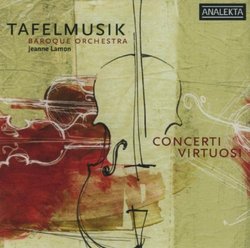| All Artists: Antonio Vivaldi, Leonardo Leo, Johann Sebastian Bach, Pietro Antonio Locatelli, Johann Friedrich Fasch, George Frederick Handel, Tafelmusik Baroque Orchestra Title: Concerti Virtuosi Members Wishing: 0 Total Copies: 0 Label: Analekta Original Release Date: 1/1/2005 Re-Release Date: 4/5/2007 Genres: Special Interest, Classical Styles: Forms & Genres, Concertos, Historical Periods, Baroque (c.1600-1750), Instruments, Strings, Symphonies Number of Discs: 1 SwapaCD Credits: 1 UPC: 774204981525 |
Search - Antonio Vivaldi, Leonardo Leo, Johann Sebastian Bach :: Concerti Virtuosi
 | Antonio Vivaldi, Leonardo Leo, Johann Sebastian Bach Concerti Virtuosi Genres: Special Interest, Classical
Baroque Concertos The musical term "concerto" has its roots in the word concertare, which in Latin means "to contend, dispute, debate," and in Italian means "to agree, arrange, get together." In the sixteenth and early se... more » |
Larger Image |
CD Details
Synopsis
Album Description
Baroque Concertos The musical term "concerto" has its roots in the word concertare, which in Latin means "to contend, dispute, debate," and in Italian means "to agree, arrange, get together." In the sixteenth and early seventeenth centuries the Italian definition prevailed, and the words concerto and concertante were used to describe music written for ensembles of voices and/or instruments. Gradually the word came to be associated primarily with instrumental music, and the Latin notion of contention crept in. The early concerti grossi were based on the popular chamber form of the trio sonata for two violins and continuo, to which were added four-part orchestral interjections. When the concertino trio played in alternation with the orchestra, a sort of contest or dialogue was created. Although composers such as Stradella had experimented with the idea of a concerto grosso as early as 1675, it is Arcangelo Corelli who both formalized and popularized the form in his landmark 1714 publication of twelve concerti grossi, Opus 6. Among his many imitators were Locatelli and Handel.

 Track Listings (6) - Disc #1
Track Listings (6) - Disc #1